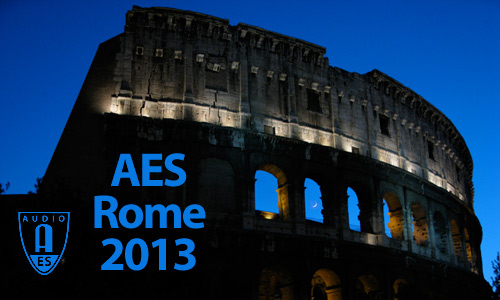
AES Rome 2013
Engineering Brief EB4
EB4 - E-Brief Posters—Part 2
Tuesday, May 7, 14:30 — 16:00 (Foyer)
EB4-1 Spatial Acoustic Synthesis—Celambarasan Ramasamy, Mind Theatre - Pasadena, CA, USA
This method leverages binaural sound synthesis to present a novel way for listeners to experience musical performances on a headphone. By separating out the notes from a musical instrument and synthesizing them individually in the space around the listener, the musical instrument is turned from a point source into a flowing musical volume that engulfs the listener. This can lead to interesting ways of thinking about a musical performance in terms of the distribution of the individual musical notes around the listener without being tied down to the notion of an individual musical instrument.
Engineering Brief 98 (Download now)
EB4-2 Enhancing the Learning of Stereo Microphone Techniques through the Use of a Simulated Learning Environment—Colin Dodds, Perth College, University of the Highlands and Islands - Perth, Scotland, UK
A key set of skills for aspiring recording engineers to acquire is that of good stereo microphone techniques. Within the world of education it is relatively straightforward to present the underpinning theory, but helping students gain the tacit knowledge necessary to achieve quality results can be difficult when access to suitable groups of musicians, spaces, and equipment is limited. A suitable learning environment was simulated within a computer program and tasks set to support the learning of stereo microphone techniques. A trial carried out on first year undergraduate sound production students revealed that using the simulated learning environment enhanced both the students’ knowledge of and ability to apply stereo microphone techniques.
Engineering Brief 99 (Download now)
EB4-3 The Good Vibrations Problem—Derry FitzGerald, Dublin Institute of Technology - Dublin, Ireland
Many of the Beach Boys’ records were mono only as this was Brian Wilson's preferred format. However, starting in the mid-1990s, stereo mixes of many of these classics were created by synchronizing the tracks from the instrumental multitrack with those of the vocal multitrack. Unfortunately, for a number of tracks, including “Good Vibrations,” elements of the multitracks were missing, making a true stereo mix impossible. This paper deals with how stereo extraction mixes were created for a number of Beach Boys’ songs using sound source separation techniques to separate sources from the original mono recordings, which were then panned to create stereo mixes. These mixes were used in reissues of Beach Boys albums in 2012.
Engineering Brief 100 (Download now)
EB4-4 Architectural Acoustics and Electroacoustics in the Asisium Theatre: An Integrated Construction Work—Luca Quaranta, CP Progetti S.r.l. - Rome, Italy
Based on the multi-functional needs, from the conference room to the cinema with Dolby Surround sound effects, we performed an analysis of the room’s acoustic response based on the model of a 3-D simulation, referenced on acoustic parameters according to ISO-3382, thus directing the choices of architectural design to obtain optimum acoustical conditions both on stage and in the audience. Design of the electroacoustic provides various control technologies for the equalization and a 6.1 Dolby Digital distribution of the amplified audio signal. In this contribution we present choices and design criteria, materials and audio devices used to obtain the final result, to underline the key role of architectural acoustics and electroacoustic integrated design.
Engineering Brief 101 (Download now)
EB4-5 Expressive Physical Modeling of Keyboard Instruments: From Theory to Implementation—Stefano Zambon, Viscount International S.p.A. - Mondaino (RN), Italy; Leonardo Gabrielli, Universitá Politecnica delle Marche - Ancona, Italy; Balazs Bank, Budapest University of Technology and Economics - Budapest, Hungary
Physics-based algorithms for sound synthesis have been extensively studied in the past decades. Nevertheless, their use in commercial synthesizers is still limited due to the difficulty in achieving realistic and easily controllable sounds with current technology. In this Engineering Brief we present an overview of the models used in Physis Piano, a digital piano recently introduced in the market with dedicated physics-based algorithms for acoustic pianos, electric pianos (e.g., Rhodes, Wurlitzer, and Clavinet), and chromatic percussions (e.g. vibraphone, marimba, xylophone). The synthesis algorithms, which are based on standard techniques such as Modal Synthesis and Digital Waveguides, have been highly customized in order to faithfully reproduce the sound features of the original instruments and are easily controllable by a set of meaningful, user-friendly parameters.
Engineering Brief 102 (Download now)
